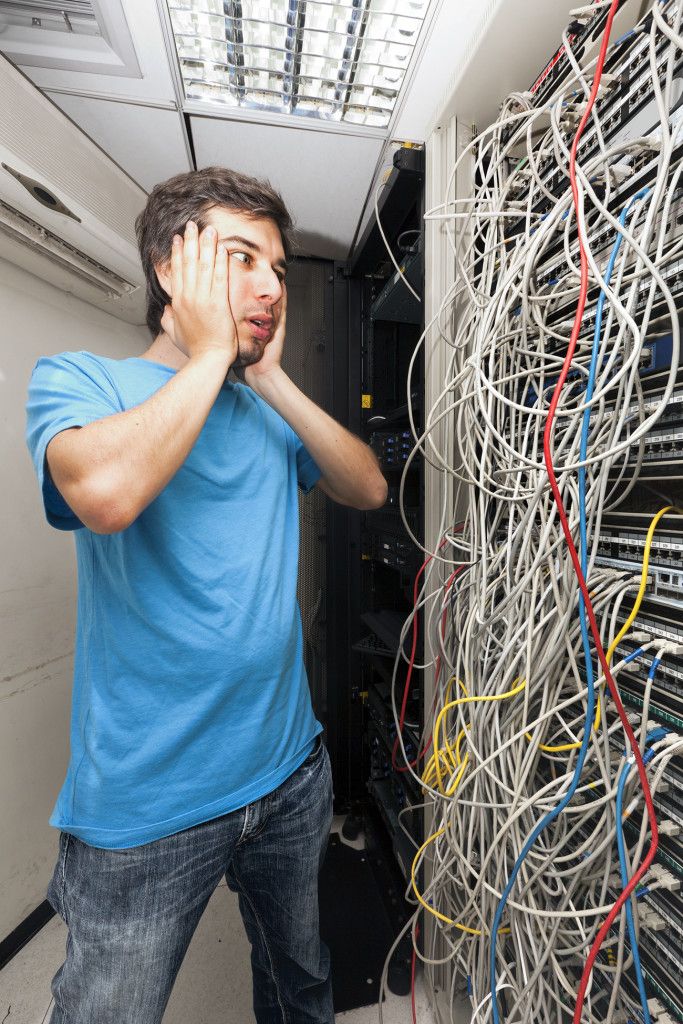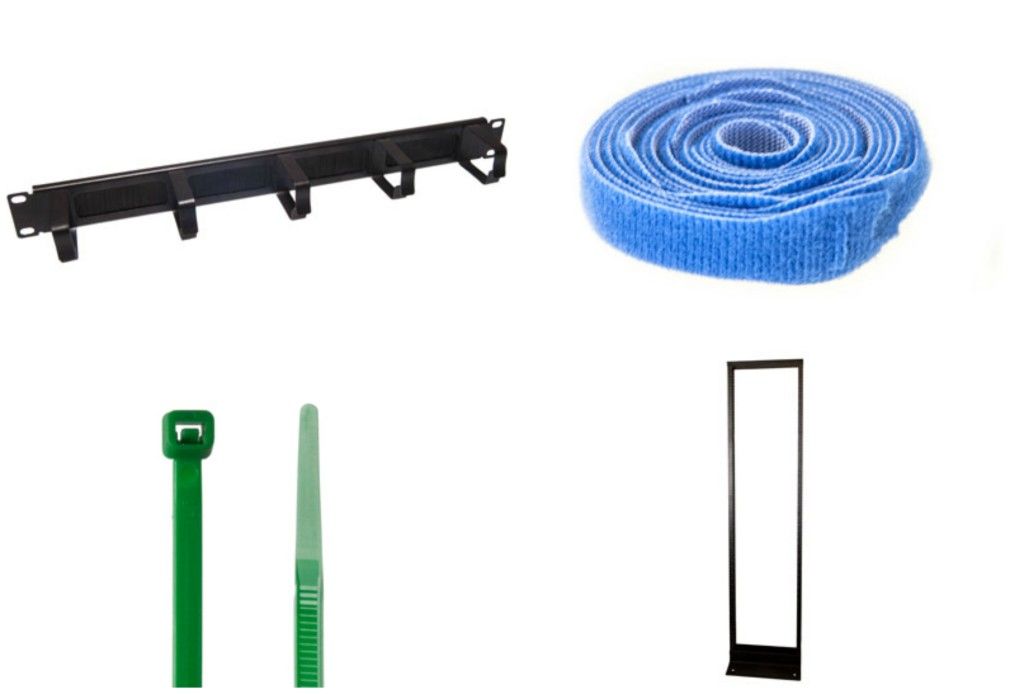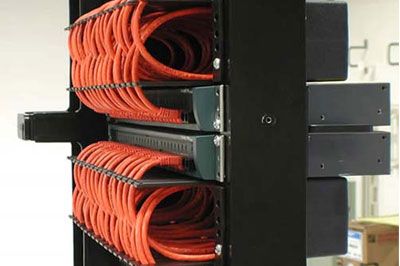Take A Stand Against Cable Spaghetti



Does your rack look like this?

Cord spaghetti isn’t only assaulting to your eyes and dignity, it can actually impede your ability to troubleshoot IT issues. If someone is experiencing connectivity problems at their desk, pinpointing the problem can be an impossibility without labeled and organized cables. Manually tracing a line into cable hell wastes precious time at best and, at worst, drives you to the brink of insanity.
Get serious about tidying up your cables. Take the pledge now!
Step 1: Admit You Have a Problem
We get it. It’s tempting to loosely string a cable from point A to point B. It’s quick, easy, and you don’t have to deal with the real issues. But you’re only hurting yourself. The next time you need to make a patch, commit to doing it the right way. It will pay off in the end.
Step 2: Clear Your Schedule
Now that you are no longer contributing to the problem, it is time to check your calendar. Block out a large chunk of time to clean up the mess. Oftentimes, you will need to work whenever the office is empty since users could lose connectivity to the network.
Step 3: Make a List of Supplies
Having the right accessories is essential to a job well done. If you have the correct supplies, it’s easier to clean up and keep your site organized. Our rack clean up essentials include:

- Finger nail clippers
- Scissors
- Labels
- Horizontal management
- Vertical cable management
Step 4: Just Do It
The final step is to bite the bullet and just start. It won’t get any easier than it is today. Assemble your supplies, set the date and go for it. You will thank yourself later.

Our Tips for Cable Management
Use the Right Size Cables
Excess cable becomes a nightmare to manage because when there is too much cable, there’s no where to put it. Invest in the right size cable, and your racks will be much more manageable.
Bundle the Cables
When making large horizontal or vertical runs, bundling the cables together makes them look nice and clean. Using cable ties, or velcro wraps will keep the cables together. You can also use them to attach your cable bundle to infrastructure pieces.
Run Cables in Channels
Instead of stringing cables randomly between devices, create a clear pathway for the cables to follow. For all cables leaving the rack, have them climb up the outer wall of the rack, cross over, crawl down the other rack, fan out horizontally and plug in.
Label Ruthlessly
While cleaning up, or better yet when first installing cables, label every single cable on the rack. This step adds a few extra minutes of labor to the installation, but provides a very clear communication to anyone who might work on the equipment. For example, if you unplug two equipment cables, having labels on them allows you to immediately know where to plug them back in.
Don’t Forget Bend Radius
Bend radius is the maximum angle that a cable can be bent. If you over-bend cables, they will break or become damaged. Then they will not function properly. This is especially true for fiber cables, which can be sensitive to bends. Proper cable management will keep your infrastructure functioning by maintaining proper bend radius.
Go forth and organize, friends!
- Cat5e & Cat6e Bulk Cable (36)
- Ecore HDMI Cables (13)
- How To Terminate RJ45 Connectors (3)
- The 5S Advantage (5)
- Network Racks (17)
- Connector (479)
-
USB
(89)
- USB Hubs (10)
-
Splitter
(51)
- Converters (24)
- Power Supply (7)
- Management Bay (2)
- Amplifier (6)
-
Adapter
(370)
- Coaxial (55)
- XLR Cables (11)
-
Tools
(36)
- Instillation Tools (12)
-
Wall Mount
(43)
- Cabinets (9)
-
Cables
(149)
- Pro Audio (82)
- Wall Plate (29)
- BNC (10)
- Wiring Cover (14)
- S-Video (6)
- Video Cables (16)
- Patch Cable (36)
- J-Hook (14)
- Power Cords (43)
- Cat7 (3)
-
Charger
(5)
- Car Charger (4)
- Wall Charger (2)
- Lightning (1)
- Data (4)
- HDMI (14)
- Adapters (2)
- Cat5e (2)
- Cat6 (2)
- Ethernet (37)
- Cat6a (4)
- RJ45 (4)
- Computer Cables (3)
- USB (2)
- FireWire (1)
- Serial (3)
- DIN (3)
- Audio Cables (3)
- 3.5mm (4)
- VGA (4)
- DVI (3)
- Optical Toslink (1)
- XLR (3)
- RCA (2)
- DisplayPort (4)
- telephone (8)
- rj11 (3)
- rj12 (3)
- coiled (0)
- flat (0)
- Coax (10)
- RF (2)
- RG (2)
- Low Loss (LMR) (2)
- fiber optic (11)
- Speaker Wire (2)
- AWG (1)
- labels (0)
- management (4)
- tape (0)
- splice (0)
- techflex (0)
- safety strip (0)
- boot (0)
- heat shrink (0)
- weatherproof (1)
- management (2)
- prep (1)
- support (1)
- extension (3)
- raceway (1)
- duct (1)
- crimp (1)
- Stripper (1)
- Cutter (1)
- surge protectors (5)
- power strips (2)
- How To Terminate Coax Connectors (0)
- antenna (1)
- satellite (1)
- detangler (1)
- DIY (11)
- banana (1)
- switch (7)
- custom (1)
- ShowMeCables (1)
- guide (1)
- Brands (1)
- multi-conductor (2)
- announcement (1)
- patch panel (2)
- keystone (3)
- ceiling mount (3)
- Pinouts (1)
- History (2)
- Certification (3)
- Organization (1)
- null modem (1)
- Television (2)
- DMX (1)
- streaming (0)
- Glossary (1)
- FAQ (1)
- Bulk Cable (1)
- Industrial (1)
- Cybersecurity (1)
- Computer Security (1)

